Around 40% of annual energy consumption in the United States is attributed to homes and commercial businesses. That means the average American spends around $2000 each year to keep their home appliances and electricity running.
But how much of that $2000 is wasted? It turns out the answer is quite a bit. Air drafts, outdated HVAC systems, and other waste accounts for around 10-25% of the average American’s energy expenditures.
As environmental concerns grow, many Americans are looking to make eco-friendly lifestyle changes. One simple and beneficial way to do so is by exploring energy-efficient home upgrades.
Energy Independence
Any time a country must import fossil fuels, it becomes increasingly dependent on foreign nations and their finite supply of natural resources. These partnerships can also be dissolved in an instant due to international tensions, shortages, or any number of other issues.
By reducing reliance on foreign energy sources, a country can bolster national energy security, in addition to supporting a more resilient domestic power grid.
Energy independence has the added impact of promoting the American economy — over 2.2 million Americans are employed in clean energy industries. That figure represents more than five times the number of people employed by dirty industries, such as oil and coal, and is only projected to increase in the coming years.
Increase Your Home’s Value
Whether or not you plan to sell your home down the line, it’s always beneficial to increase your property’s value. You never know when a new job or unexpected circumstance might lead you to sell.
In addition to saving you money on your monthly utility bill, energy-efficient homes have the potential to dramatically increase your home’s market value. A high level of energy efficiency is one way to get a greater home appraisal, which is every homeowner’s dream.
Lower Your Utility Bills
Some people may be reluctant to consider energy-efficient appliances because of the higher initial cost. Besides the numerous local rebates, loans, discounts, and financial help that may be available to you when purchasing these appliances, there are other benefits to keep in mind.
Energy-efficient appliances and measures can decrease your annual energy costs by around 25%, as estimated by the U.S. Department of Energy. By plugging any leaks and assessing your home’s energy weaknesses, you can take your first steps toward lowering your utility bills while saving the environment.
Examples of Energy-Efficient Upgrades
No matter how much energy your household is currently consuming, there is always room for improvement. Try out the following popular methods to increase the energy efficiency of your home.
Solar Panels
Solar energy is rapidly increasing in popularity, likely due to its unlimited renewability and abundance. Each year, this option becomes more and more accessible to everyday Americans, making it an option to consider for your home.
Because of the initial investment required to procure and install solar panels, some homeowners overlook the energy savings they offer. In general, however, you’ll begin to see returns on your initial investment at around the four- to seven-year mark, making a renovation that is, in the long run, worth it.
CFL/LED Lighting
Upgrading your lighting is one of the simpler energy-efficient upgrades you can undertake. While lighting usually composes a relatively small percentage of your energy consumption, it’s an easy area in which to make improvements.
Both compact fluorescent lamps (CFLs) and light-emitting diodes (LEDs) will dramatically reduce your energy usage. They also last extraordinarily long when compared to standard bulbs, ensuring you get more for your money.
Home Appliances
You end up paying for your home appliances twice: once upon the initial purchase and then again based on the operating costs. When browsing household appliances, keep your eyes peeled for an Energy Star rating. Appliances with an Energy Star certification use less while operating and when in standby mode.
Refrigerators and clothes dryers are two of the most energy-intensive appliances in most houses, making it crucial that they run efficiently. So, when the time comes to upgrade one of these appliances, keep energy efficiency at the forefront of your mind.
Targeting Waste
Do you have drafty windows or spotty insulation? What about your thermostat – do you make use of its programmable features to save money while you’re at work or on vacation?
In addition to purchasing energy-efficient fixtures for your home, one way to reduce your energy consumption is to identify waste. You can even hire a professional to conduct an energy evaluation of your home to help determine where energy goes to waste.
Other Gadgets
Until you’ve gone fully green, small shifts can help to reduce your carbon footprint and overall energy usage. In addition to purchasing energy-efficient appliances and installing eco-friendly bulbs, small household gadgets like thermal leak detectors and energy-efficient toasters can help you cut back on energy consumption while adding some extra padding to your wallet.
It’s a win-win situation when energy-efficient home upgrades pay for themselves. Start on your journey toward a more efficient, enjoyable home today!
 Alternative Energy HQ solar power for homes, wind energy, and bio fuel issues
Alternative Energy HQ solar power for homes, wind energy, and bio fuel issues








